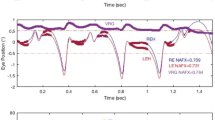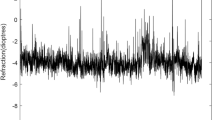Summary
Monkeys wore either base-out prisms to promote changes in tonic vergence or periscopic spectacles to promote changes in the coupling between accommodation and vergence. Eye movements were recorded using the magnetic search coil technique and the monkeys were rewarded for accurate fixation. Two normal monkeys and two monkeys which had previously received lesions of the flocculus and ventral paraflocculus were studied. After 30 min of prism viewing the two normal monkeys had elevated phoria — increased by approximately 50% of the prism stimulus. The two lesioned monkeys also had phoria increases of a similar size after prism viewing. The effect of duration of prism viewing on the magnitude and time course of phoria elevation was studied in one normal monkey. The initial magnitude of phoria elevation and the time constant of relaxation of phoria both increased as the duration of prism exposure varied from 5 s to 30 min. Initial phoria increased approximately in proportion to the logarithm of duration of prism exposure whereas the time constant of phoria relaxation increased linearly with duration. In the same normal monkey it was shown that increasing vergence by means of accommodative-vergence did not induce phoria changes. The effect of periscopic spectacle viewing was studied in all four monkeys. After 30 min of periscopic spectacle viewing all four monkeys had a higher AC/ A ratio. The magnitude of the changes was (paradoxically) greater in the two lesioned monkeys than in the one normal monkey studied fully. The increases in AC/A ratio were moderately persistent, relaxing back to control values with time constants (in the lesioned monkeys) of the order of two hours.
Similar content being viewed by others
References
Alpern M, Kincaid WM, Lubeck MJ (1959) Vergence and accommodation. III. Proposed definitions of the AC/A ratios. Am J Ophthalmol 48: 143–148
Alpern M (1969) Types of eye movement. In: Davson H (ed) The eye, Vol 3, 2nd edn. Academic Press, New York, pp 65–174
Armitage P (1971) Statistical methods in medical research. Black-well, Oxford
Carter DB (1965) Fixation disparity and heterophoria following prolonged wearing of prisms. Am J Optom Arch Am Acad Optom 42: 141–152
Chin NB, Ishikawa S, Lappin H, Davidowitz J, Breinin GM (1968) Accommodation in monkeys induced by midbrain stimulation. Inv Ophth 7: 386–396
Ciuffreda KJ, Kenyon RV (1983) Accommodative-vergence and accomodation in normals, amblyopes and strabismics. In: Schor CM, Ciuffreda KJ (eds) Vergence eye movements: basic and clinical aspects. Butterworths, Boston, pp 101–173
Cumming BG, Judge SJ (1984) Neural mechanisms of convergence and accommodation. In: Gale AG, Johnson F. (eds) Theoretical and applied aspects of eye movement research. Elsevier, Amsterdam, p 429–437
Flom MC (1960) On the relationship between accommodation and accommodative convergence. I. Linearity. Am J Optom Arch Am Acad Optom 37: 474–482
Friendlich AR (1973) Primate head restrainer using a nonsurgical technique. J. Appl Physiol 35: 934–935
Green DG, Powers MK, Banks MS (1980) Depth of focus, eye size and visual acuity. Vision Res 20: 827–835
Henson DB, North R (1980) Adaptation to prism-induced heterophoria. Am J Optom Physiol Opt 57: 129–137
Judge SJ, Richmond BJ, Chu FC (1980) Implantation of magnetic search coils for measurement of eye position: an improved method. Vision Res 20: 535–538
Judge SJ, Miles FA (1981) Gain changes in accommodative-vergence induced by alteration of the effective interocular separation. In: Fuchs AF, Becker W (eds) Progress in oculomotor research. Elsevier, Amsterdam, pp 587–594
Judge SJ, Miles FA (1985) Changes in the coupling between accommodation and vergence eye movements induced in human subjects by altering the effective interocular separation. Perception 14: 617–629
Larsell O (1970) The comparative anatomy and histology of the cerebellum from monotremes through apes, Jansen J (ed). University of Minnesota Press, Minneapolis Minnesota
Lisberger, S.G., Miles FA, Zee DS (1984) Signals used to compute errors in monkey vestibuloocular reflex: possible role of flocculus. J Neurophysiol 52: 1140–1153
Maddox EE (1893) The clinical use of prisms. John Wright and Sons, Bristol
Madigan JC and Carpenter MB (1971) Cerebellum of the rhesus monkey. University Press, Baltimore
Martens TG, Ogle KN (1959) Observations on accommodative convergence: especially its nonlinear relationships. Am J Ophthalmol 47: 455–462
Milder DG, Reinecke RD (1983) Phoria adaptation to prisms. Arch Neurol 49: 339–342
Miles FA (1985) Adaptive regulation in the vergence and accommodation control systems. In: Berthoz A, Melvill Jones G (eds) Reviews of oculomotor research, Vol 1. Adaptive mechanisms in gaze control. Elsevier, Amsterdam, pp 81–94
Miles FA, Fuller JH, Braitman DJ, Dow BM (1980) Long-term adaptive changes in primate vestibuloocular reflex. III. Electrophysiological observations in flocculus of normal monkeys. J Neurophysiol 43: 1437–1476
Miles FA, Judge SJ (1982) Optically-induced changes in the neutral coupling between vergence eye movements and accommodation in human subjects. In: Lennerstrand G, Zee DS, Keller E (eds) Functional basis of ocular motility disorders. Pergamon, Oxford, pp 93–96
Mitchell AM, Ellerbrock VJ (1955) Fixation disparity and the maintenance of fusion in the horizontal meridian. Am J Optom Arch Am Acad Optom 32: 520–534
Ogle KN, Martens TG, Dyer JA (1967) Oculomotor inbalance in binocular vision and fixation disparity. Lea and Febiger, Philadelphia
Optican LM, Robinson DA (1980) Cerebellar dependent adaptive control of the primate saccadic system. J. Neurophysiol 44: 1058–1076
Schor CM (1979a) The influence of rapid prism adaptation upon fixation disparity. Vision Res 19: 757–765
Schor CM (1979b) The relationship between fusional vergence eye movements and fixation disparity. Vision Res 19: 1359–1367
Schor CM (1983) Fixation disparity and vergence adaption. In: Schor CM and Ciuffreda KJ (eds) Vergence eye movements: basic and clinical aspects. Butterworths, Boston, pp 647–670
Wurtz RH (1969) Visual receptive fields of striate cortex neurons in awake monkeys. J Neurophysiol 32: 727–742
Zee DS, Yamazaki A, Butler PH, Gucer G (1981) Effects of ablation of flocculus and paraflocculus on eye movements in primate. J Neurophysiol 46: 878–899
Author information
Authors and Affiliations
Rights and permissions
About this article
Cite this article
Judge, S.J. Optically-induced changes in tonic vergence and AC/A ratio in normal monkeys and monkeys with lesions of the flocculus and ventral paraflocculus. Exp Brain Res 66, 1–9 (1987). https://doi.org/10.1007/BF00236195
Received:
Accepted:
Issue Date:
DOI: https://doi.org/10.1007/BF00236195




